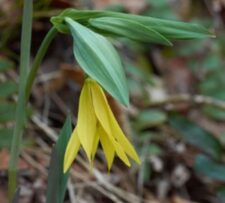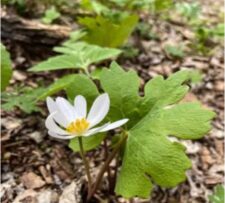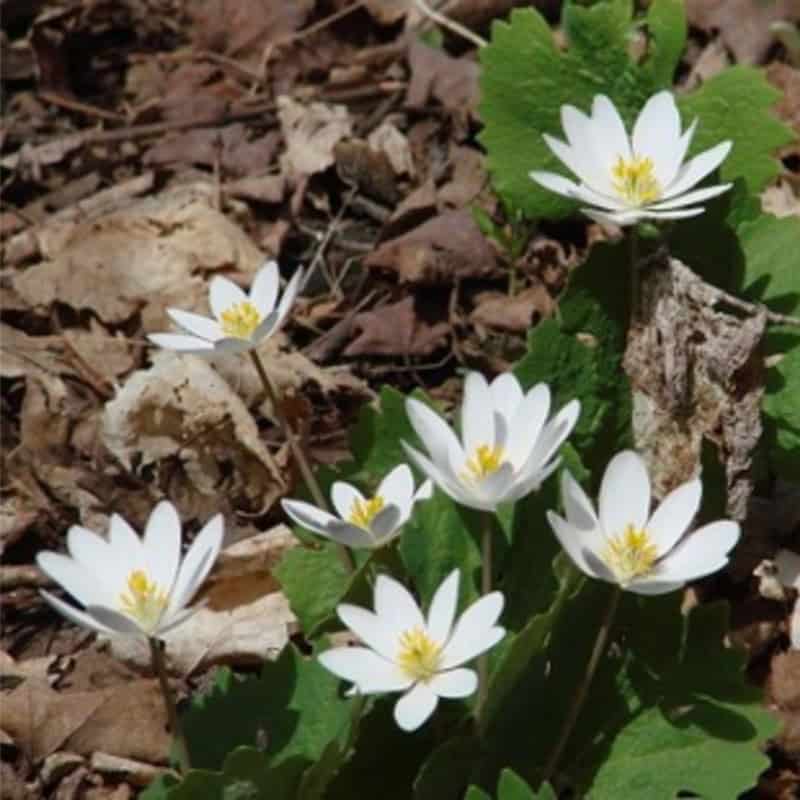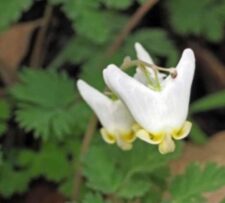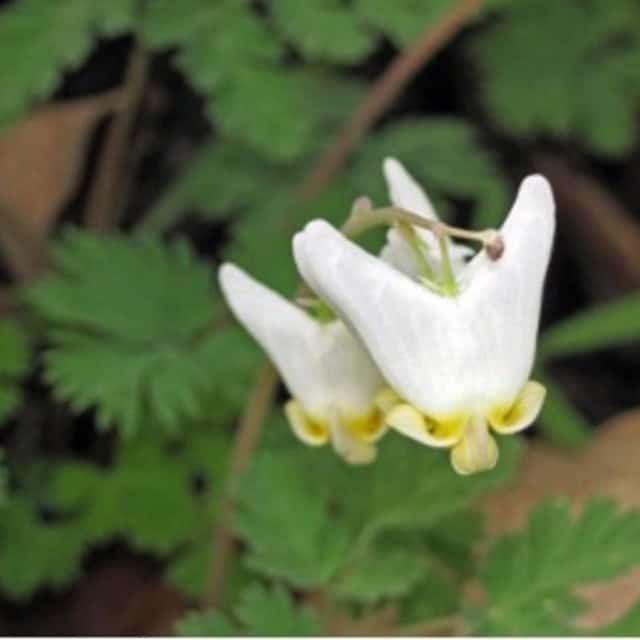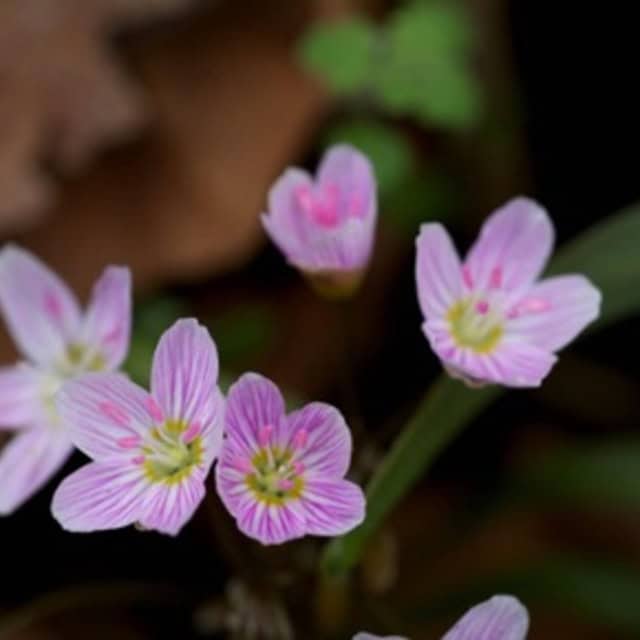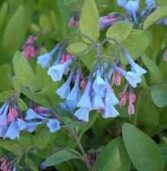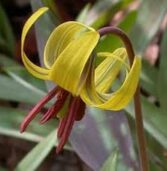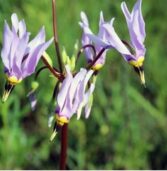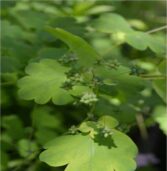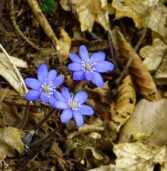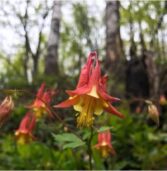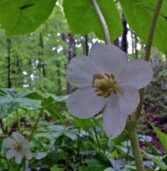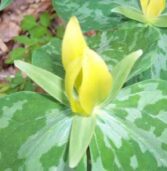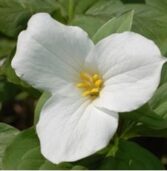Early-Blooming (Spring*)
Wildflower Plants
An Identification Guide
*grouping is approximate since many bloom times overlap.
The majority of the plants growing in the Wildflower Garden were native to mid-central North America before the arrival of European settlers.
Some species are found throughout the garden, others occur naturally.
Bellwort-Great Merrybells
Bellwort-Great Merrybells
Uvularia grandiflora
- Life Cycle: Perennial
- Bloom Time: April-May
- Sun Exposure: Partial Shade
- Bloom color: Yellow
Bellwort is an excellent early-blooming native shade plant for the woodland garden, shaded border front, wildflower garden or naturalized area. It spreads slowly by rhizomes so you can achieve a mass planting look under shade trees or along wood margins in a relatively short amount of time. The Bellwort flowers and leaves have an overall droopy appearance when in bloom. However, after seeds are set, the leaves of Uvularia take on a different look, somewhat like a needle threading the stem through the leaves.
Bloodroot
Bloodroot
Sanguinaria canadensis
- Life Cycle: Perennial Ephemeral
- Bloom time: April, May
- Sun Exposure: Partial/shade
- Bloom Color: White
Bloodroot emerges from the ground in woodlands before the trees leaf out. Plants display their beauty in 2 stages:
- Stunning white blossoms appear for a very short time in early spring, emitting a wonderful fragrance that attracts many kinds of early-flying pollinators. The stems of Bloodroot have a reddish juice (see photo) that is toxic to herbivores.
- At the flowering stage, a light green leaf is wrapped around the stem of the flower.
When the flower fades, the leaf opens in a very unique shape as large as 6" in diameter. Bloodroot will go dormant mid-summer.
Dutchman’s Breeches
Dutchman's Breeches
Dicentra cucullaria
- Life Cycle: Ephemeral
- Bloom Time: April-May
- Sun Exposure: Partial, Full Shade
- Bloom color: White
Dutchman's Breeches is a wildflower of the Dicentra clan, similar to the Dicentra bleeding heart. Blooms (called spurs) are similar to those of the bleeding-heart plant, but shaped differently, more like a pair of pantaloons than a heart -- thus, the common name of Dutchman's Breeches. Dutchman's Breeches wildflower is often found growing with squirrel corn and together earn the nickname,”boys and girls.” The plant propagates through underground rhizomes or seeds carried by bumblebees.
Spring Beauty
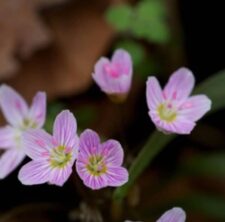
Spring Beauty
Claytonia virginica
- Life Cycle: Perennial, Ephemeral
- Bloom Time April, May
- Sun Exposure: Partial/shade
- Bloom Color: Pink
When the snow starts to melt and early spring wildflowers begin to emerge, the beauty of the spring is all around us. What better wildflower to enjoy at this time than Spring Beauty (Claytonia virginica)!
The early flowering of this small woodland plant is great for pollinators including manyspecies of bees. Because Spring Beauty can survive in more degraded habitats compared to most spring-blooming woodland species, it is still relatively common to see wild populations throughout the Midwestern and Eastern US.
The flower color is pale pink from a distance but a close look reveals five white petals striped with pink.
Virginia Bluebells

Virginia Bluebells
Mertensia virginica
- Life Cycle: Ephemeral
- Bloom Time: April May
- Sun Exposure: Partial Shade
- Bloom Color: Blue
One of the most beautiful species of spring ephemerals are Virginia bluebells (Mertensia virginica). These lovely plants are in the family Boraginaceae, which makes them relatives of other familiar species like Forget-me-not, Lungwort, and Comfrey. Bluebells enjoy rich, well-drained soils where they can form large colonies over time. Growing fast, the flower shoots quickly give way to some of the most beautiful flowers east of the Mississippi.
The flowers start off pink and gradually turn over to their famous shade of light blue as they mature. A colony of bluebells is truly an amazing sight to behold! The blooms will last for many weeks in early spring (April and May) and will go dormant by mid-summer.
Virginia Bluebells prefer soils typical of a woodland - rich and a little on the wet side.
Toothwort
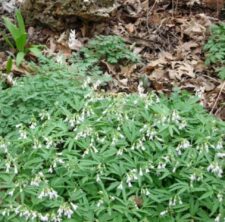
Toothwort
Cardamine concatenata
- Life Cycle: Perennial
- Bloom Time: April, May
- Sun Exposure: Shade
- Bloom Color: White
Toothwort is one of the first plants to bloom in spring; providing much-needed nectar to early spring-flying insects. Dozens of white to pale-pink flowers will cover a healthy colony of plants just a few years after transplant or division.
It is also called Cutleaf Toothwort and Dentaria laciniata.
It will go dormant mid-summer.
Trout Lily
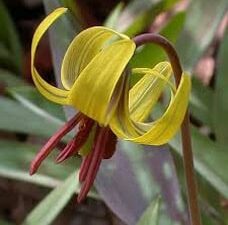
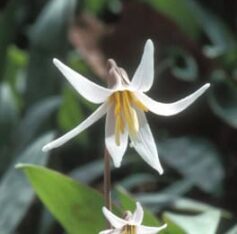
Trout Lily
Erythronium
- Life Cycle: Ephemeral
- Bloom Time: April, May
- Sun Exposure: Shade
- Bloom Color: Yellow, White
Trout Lily has tulip-like green leaves with silvery-maroon mottled markings. The plants will spread slowly to form colonies, but can take many years to flower.
A single, very attractive flower will bloom for just a few days on mature plants early in the spring. The plant will fade into dormancy by mid-summer. Also called Dog Tooth Violets, these lovely spring ephemerals are just what you need to see after a long, dreary winter. White Trout Lilies are spreaders. Their underground roots will bud off new plants and in only a few seasons, a couple plants can spread into many. Trout Lilies offer pollinators a much needed meal during a time when little else is available.
Midland Shooting Star
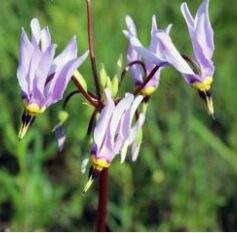
Midland Shooting Star
Dodecatheon meadia
- Life Cycle: Ephemeral
- Bloom Time: April-June
- Sun Exposure: Full, Partial
- Bloom Color: White
The early spring plants tend to get the most attention because we so need to see flowers at that time of year. Shooting Stars deserve the acclaim. They are true spring ephemeral of the prairie; they are completely done with their season and go dormant by mid summer. They have beautiful mahogany colored seed pods that are often not noticed because other tall species have over-topped them by that time. Midland Shooting Star, often called just 'Shooting Star', can become very robust with a few dozen flowers coming out of each plant, especially in moist, rich soils.
Early Meadow Rue

Early Meadow Rue
Thalictrum dioicum
- Life Cycle: Ephemeral
- Bloom Time: April-May
- Sun Exposure: Partial, Shade
- Bloom Color: Green
Early Meadow Rue is an excellent shade-garden plant. Use it to fill in where many of your early spring woodland flowers will go dormant. It is valued for its delicate green fern-like foliage, which will last spring through fall. The greenish-yellow flowers resemble little tassles and bloom in early spring when the leaves have not quite opened and the canopy of the trees above is not yet shading the woodland floor. Early Meadow Rue can take partial sun as well and thrives in moist through well-drained soils. Other common names in use include Quicksilver Weed.
Hepatica, Sharp-Lobed

Hepatica, Sharp-Lobed
Hepatica acutiloba
- Life Cycle: Ephemeral
- Bloom Time: April-May
- Sun Exposure: Partial, Shade
- Bloom Color: White, Pink, Blue
As the first spring ephemeral to bloom in the forest, Sharp-lobed Hepatica is a delightful sight after a long winter. John Burroughs, the famous 19th century American naturalist, once said, “There are many things left for May, but nothing fairer, if as fair, as the first flower, the hepatica..” This petite little plant can be a variety of colors including white, pink and blue.
Hepatica can be identified by the distinctive, mottled leaves which turn a crimson color in the fall. In late winter, the bright red color of last year's leaves are a good indication of where the new blooms will appear come spring. The appearance of the leaves has inspired another common name, "Liverleaf." The name references the perceived similarity of the leaf shape to the human liver. Ancient herbalists believed in the "Doctrine of Signatures," the idea that the cures to medical ailments could be found in the plants that resembled the diseased human body part. Hepatica was creatively imagined to be shaped like a liver, and as such, it was historically used to treat ailments of the liver. Like many plants believed to have medicinal qualities, Hepatica was almost over-harvested to the brink of extinction. Modern medical science has shown Hepatica to have no medical efficacy, and the Doctrine of Signatures has also since been proven to be pseudoscience.
American Columbine
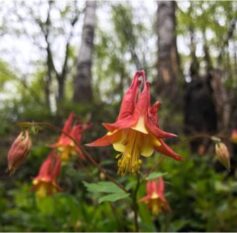
American Columbine
Aquilegia canadensis
- Life Cycle: Perennial
- Bloom Time: April-June
- Sun Exposure: Partial, Shade
- Bloom Color: Red
Columbine, also called Red or American Columbine, is the larval host plant of the Columbine Duskywing. The colorful flowers are red flowing into yellow. Besides being an early bloomer, Columbine will tolerate a large range of soil and sun types, so you'll have success with it in full sun as well as shade. The seeds of Aquilegia are shiny black and smooth - like
tiny black pearls. They can bounce on hard soil surfaces, aiding in their distribution.
Jack-in-the-Pulpit

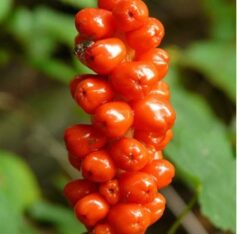
Jack-in-the-Pulpit
Arisaema triphyllum
- Life Cycle: Perennial
- Bloom Time: April-July
- Sun Exposure: Partial Shade
- Bloom Color: Green, Red
Jack-in-the-Pulpit is an excellent woodland garden plant. It thrives under a variety of conditions, but grows best in rich soil, shady, seasonally wet locations. The "Jack" is the spongy cylindrical structure, inside a leaf-like structure that is rolled into a deep cup with an overhanging roof, the "pulpit". The plant is said to have a burning, peppery taste so herbivores will not eat it but the berries are a food source for birds. These berries form mid-summer and are smooth, shiny green, 1 cm wide clustered on the thickened spadix, turning a bright red color before the plants go dormant early fall.
May Apple
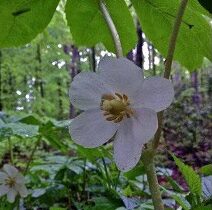
May Apple
Podophyllum peltatum
- Life Cycle: Perennial
- Bloom Time: May-June
- Sun Exposure: Partial, Shade
- Bloom Color: White
For those of you that struggle with what to plant under pines that leave dry, semi-shady conditions, They can be quite aggressive, but have attractive, short, green foliage that look almost like umbrellas to protect the large white flower which blooms in May and June. Also called Devil's Apple, Hog-apple, and Indian Apple.
Caution: May Apple root can be toxic and should only be used by experienced herbalists. The seeds and rind are not edible, and are said to be poisonous. The whole plant, apart from the ripe fruit, is highly poisonous in large doses.
Yellow Trillium
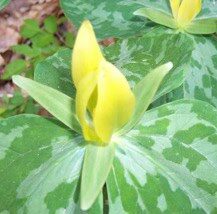

Yellow Trillium
Trillium luteum
- Life Cycle: Perennial
- Bloom Time: April-June
- Sun Exposure: Partial, Shade
- Bloom Color: Yellow
Easily grown in rich medium soils, Trillium luteum is tolerant of heavy clay with decent topsoil. The plants are very long-lived, up to 25 years, but can take a few years to mature. Yellow Wakerobin Trillium spreads slowly if left undisturbed in the shade garden or naturalized wooded area. It combines well with other spring wildflowers such as Virginia Bluebells, Jacob's Ladder, and Wild Blue Phlox. The foliage will die back, so plant them with along with shade-loving ferns to share their place until they reappear the following spring.
White Trillium
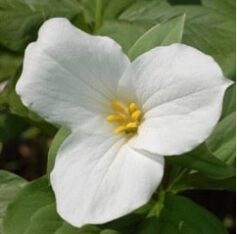
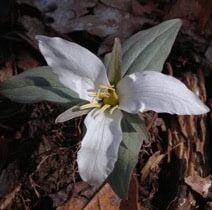
White Trillium
Trillium grandiflorum
- Life Cycle: Perennial
- Bloom Time: April-June
- Sun Exposure: Partial, Shade
- Bloom Color: White
Commonly called White Trillium, Great White Trillium, or Snow Trillium, this plant is a "must-have" for any woodland area in the Midwest or Northeast. Trillium grandiflorum's stunning white flowers can reach 4" in diameter and will take on an equally head-turning pink hue when reaching the end of their bloom cycle.
The common name Wake Robin is less used today, but it no doubt referred to the early April and May bloom time, corresponding with the appearance of the Robin. Trilliums are members of the Lily family.
Trillium Toad
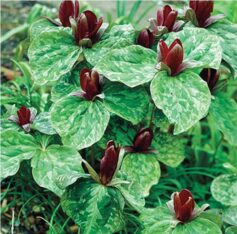
Trillium Toad
Trillium sessile
- Life Cycle: Perennial
- Bloom Time: April-June
- Sun Exposure: Partial, Shade
- Bloom Color: Red
A charming addition to shady spaces or sun-dappled gardens, Toad Trillium, also known as Trillium sessile, produces small tri-petaled blooms in a range of hues from dark red to maroon to brownish-purple. The little flowers pop against highly ornamental mottled foliage, giving the entire area a dynamic look sure to please. Plant in groups under deciduous trees or between evergreen shrubs to brighten up the scene with color and light. Blooms appear from April to May in zones 4-8. Butterflies love this low-growing perennial and will visit the landscape often. Trillium is a wildflower native to the U.S. and grows quite readily and dependably.

